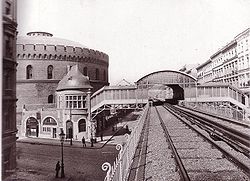
Prinzenstraße (Berlin U-Bahn)
Encyclopedia

Berlin U-Bahn
The Berlin is a rapid transit railway in Berlin, the capital city of Germany, and is a major part of the public transport system of that city. Opened in 1902, the serves 173 stations spread across ten lines, with a total track length of , about 80% of which is underground...
station located on the .
Overview
It is located roughly where the eponymous street crosses the LandwehrkanalLandwehrkanal
The Landwehr Canal, or Landwehrkanal in German, is a long canal parallel to the Spree river in Berlin, Germany, built between 1845 and 1850 according to plans by Peter Joseph Lenné...
in Kreuzberg
Kreuzberg
Kreuzberg, a part of the combined Friedrichshain-Kreuzberg borough located south of Mitte since 2001, is one of the best-known areas of Berlin...
. The nearby Böcklerpark, a small park with a hall where music events are often held, and the Sommerbad Kreuzberg swimming pool, colloquially called Prinzenbad, are among the most popular venues in central Kreuzberg
Kreuzberg
Kreuzberg, a part of the combined Friedrichshain-Kreuzberg borough located south of Mitte since 2001, is one of the best-known areas of Berlin...
. The street and subsequently the station were named after Prince William I
William I, German Emperor
William I, also known as Wilhelm I , of the House of Hohenzollern was the King of Prussia and the first German Emperor .Under the leadership of William and his Chancellor Otto von Bismarck, Prussia achieved the unification of Germany and the...
, the later German Emperor.
The station on the first Berlin U-Bahn line from Potsdamer Platz
Berlin Potsdamer Platz railway station
Berlin Potsdamer Platz is a railway station in Berlin. It is completely underground and situated underneath the Potsdamer Platz in central Berlin. Regional and S-Bahn services call at the station.- History :...
to Stralauer Tor
Stralauer Tor (Berlin U-Bahn)
Stralauer Tor was a Berlin U-Bahn station in Berlin-Friedrichshain. As an elevated station built into the north-eastern part of the Oberbaumbrücke viaduct, it operated between Warschauer Straße and Schlesisches Tor stations on today's U1...
was opened on February 18, 1902. Because the station is on a viaduct
Viaduct
A viaduct is a bridge composed of several small spans. The term viaduct is derived from the Latin via for road and ducere to lead something. However, the Ancient Romans did not use that term per se; it is a modern derivation from an analogy with aqueduct. Like the Roman aqueducts, many early...
above the junction of Prinzenstraße and Gitschiner Straße, a street level entrance hall could only be erected on its south side on the grounds of a gas plant
Gasification
Gasification is a process that converts organic or fossil based carbonaceous materials into carbon monoxide, hydrogen, carbon dioxide and methane. This is achieved by reacting the material at high temperatures , without combustion, with a controlled amount of oxygen and/or steam...
, while the stairs to the northern platform had to be included in the opposite residential building.
Destroyed in World War II
World War II
World War II, or the Second World War , was a global conflict lasting from 1939 to 1945, involving most of the world's nations—including all of the great powers—eventually forming two opposing military alliances: the Allies and the Axis...
, the station was rebuilt in the 1950s. It later received new entrance halls in a hotly disputed Postmodern
Postmodern architecture
Postmodern architecture began as an international style the first examples of which are generally cited as being from the 1950s, but did not become a movement until the late 1970s and continues to influence present-day architecture...
style, in 1984 for the north wing and 1991 for the south wing. Inside, a preserved detail of the old station is found at the northern platform, a small sculpture of a frog with a crown and a ball, alluding to the Frog Prince
The Frog Prince (story)
"The Frog Prince; or, Iron Henry" is a fairy tale, best known through the Brothers Grimm's written version; traditionally it is the first story in their collection. In the tale, a spoiled princess reluctantly befriends a frog , who magically transforms into a handsome prince...
fairy tale.

